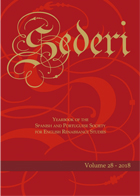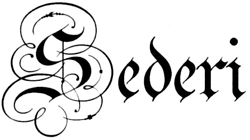
Sederi 28
Sederi 28 — 2018
EDITOR
Ana Sáez-Hidalgo
MANAGING EDITOR
Francisco J. Borge López
REVIEW EDITOR
María José Mora
ISSN 1135-7789
Zümre Gizem Yılmaz,“’The sweet fruition of an earthly crown’: Elemental mastery and ecophobia in Tamburlaine the Great and Doctor Faustus.” SEDERI 28 (2018): 79–96.
DOI: https://doi.org/10.34136/sederi.2018.4 Download PDF
Abstract
Although the elements have been exploited for human ends in early modern discursive practices, they have so saturated social and cultural life that writers of the period could not avoid mentioning elemental formations. Marlowe’s Tamburlaine, Part I and Part II (1587) and Doctor Faustus (1592) are significant representatives of early modern English drama that highlight the inter-relationships between the human body and the elements. This study examines elemental agency, to show how the agential capacity of the four classical elements unveils ecophobic treatment; and how the ecophobic strain in the human psyche is reflected in Christopher Marlowe’s Tamburlaine and Doctor Faustus.
Keywords: ecophobia; elemental ecocriticism; Christopher Marlowe; Tamburlaine; Doctor Faustus.
References
Bachelard, Gaston. 1964. The Psychoanalysis of Fire. Translated by Alan C. M. Ross. London: Routledge and Kegan Paul.
Borlik, Todd Andrew. 2011. Ecocriticism and Early Modern English Literature: Green Pastures. New York: Routledge.
Cohen, Jeffrey Jerome. 2015. Stone: An Ecology of the Inhuman. Minneapolis: University of Minnesota Press.
Cohen, Jeffrey Jerome, and Linda T. Elkins-Tanton. 2017. Object Lessons: Earth. New York: Bloomsbury.
Cohen, Jeffrey Jerome, and Lowell Duckert. 2015. “Introduction: Eleven Principles of the Elements.” Elemental Ecocriticism: Thinking with Earth, Air, Water, and Fire, edited by Jeffrey Jerome Cohen and Lowell Duckert, 1–20. Minneapolis: University of Minnesota Press.
Daly, Nicholas. 2011. “The Volcanic Disaster Narrative: From Pleasure Garden to Canvas, Page, and Stage.” Victorian Studies 53 (2): 255–85.
Daniel, Drew. 2014. “The Empedoclean Renaissance.” In The Return of Theory in Early Modern English Studies, edited by Paul Cefalu, Gary Kuchar, and Bryan Reynolds, 277–300. London: Palgrave Macmillan.
Estok, Simon. 2008. “Doing Ecocriticism with Shakespeare.” In Early Modern Ecostudies: From the Florentine Codex to Shakespeare, edited by Thomas Hallock, Ivo Kamps, and Karen L. Raber, 77–91. New York: Palgrave Macmillan.
Estok, Simon. 2011. Ecocriticism and Shakespeare: Reading Ecophobia. New York: Palgrave Macmillan.
Feerick, Jean E., and Vin Nardizzi. 2012. “Swervings: On Human Indistinction.” In The Indistinct Human in Renaissance Literature, edited by Jean E. Feerick and Vin Nardizzi, 1–12. New York: Palgrave Macmillan.
Halpern, Richard. 2004. “Marlowe’s Theater of Night: Doctor Faustus and Capital.” ELH 71 (2): 455–95.
Harris, Anne. 2015. “Pyromena: Fire’s Doing.” Elemental Ecocriticism: Thinking with Earth, Air, Water, and Fire, edited by Jeffrey Cohen and Lowell Duckert, 27–54. Minneapolis: University of Minnesota Press.
Hiltner, Ken. 2014. “Early Modern Ecocriticism.” The Return of Theory in Early Modern English Studies, edited by Paul Cefalu, Gary Kuchar and Bryan Reynolds, 81–93. London: Palgrave Macmillan.
Hopkins, Lisa. 2005. A Christopher Marlowe Chronology. New York: Palgrave Macmillan.
Kelly, Jack. 2004. Gunpowder, Alchemy, Bombards, and Pyrotechnics: The History of the Explosive That Changed the World. New York: Basic.
Macauley, David. 2010. Elemental Philosophy: Earth, Air, Fire, and Water as Environmental Ideas. Albany: State University of New York Press.
MacInnes, Ian. 2012. “The Politic Worm: Invertebrate Life in the Early Modern English Body.” In The Indistinct Human in Renaissance Literature, edited by Jean E. Feerick and Vin Nardizzi, 253–73. New York: Palgrave Macmillan.
Marcus, Leah S. 1996. Unediting the Renaissance: Shakespeare, Marlowe, Milton. London: Routledge.
Marlowe, Christopher. 2008. Doctor Faustus and Other Plays. Oxford: Oxford University Press.
Mentz, Steve. 2015. “Phlogiston.” Elemental Ecocriticism: Thinking with Earth, Air, Water, and Fire, edited by Jeffrey Cohen and Lowell Duckert, 55–76. Minneapolis: University of Minnesota Press.
Nicolson, Marjorie. 1938. “Milton’s Hell and the Phlegraean Fields.” University of Toronto Quarterly 7 (4): 500–13.
Rudnick, Hans H. 1988. “Fire in Goethe’s Work: Neptunism and Volcanism.” In Poetics of the Elements in the Human Condition: The Airy Elements in Poetic Imagination, Breath, Breeze, Wind, Tempest, Thunder, Snow, Flame, Fire, Volcano …, edited by Anna-Teresa Tymieniecka, 65–71. Berlin: Springer Science.
Simkin, Stevie. 2001. Marlowe: The Plays. New York: Palgrave.
Spence, Leslie. 1927. “Tamburlaine and Marlowe.” PMLA 42 (3): 604–22.
Steel, Karl. 2015. “Creeping Things: Spontaneous Generation and Material Creativity.” In Elemental Ecocriticism: Thinking with Earth, Air, Water, and Fire, edited by Jeffrey Jerome Cohen and Lowell Duckert, 209–36. Minneapolis: University of Minnesota Press.
